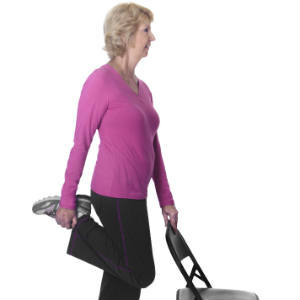If you have osteoporosis, you may worry that exercising might put so much stress on your bones that fractures will result. But, as an in-depth article about osteoporosis and exercise in USNews.com shares, working out actually helps to prevent those injuries. Our skeletal system, as one expert shares, actually needs the type of stress that exercise provides–needs it to “help remodel and grow new bone. This keeps our bones from becoming brittle and maintains their integrity.”
In short, use it or lose it.
Exercise also helps to boost balance and muscle strength, both of which help to prevent falls. And, because falls can be especially devastating for people with this bone-loss condition, it’s crucial for them to safely and appropriately exercise.
If you have osteoporosis, talk to your doctor before starting an exercise program. And, here are three tips that focus on safely exercising with osteoporosis.
Tip #1: Perform Weight-Bearing Exercises with Resistance
These types of exercise are the best kind for people with osteoporosis to perform. When muscles contract and work during resistance, the muscles pull on tendons that connect to bone. With regular exercise, the bone by the tendons will strengthen to accommodate demand.
With weight-bearing exercises, as you stand, your bones must support your body’s weight, and the downward pressure helps trigger bone growth. Specific weight-bearing exercises that also provide resistance include:
- Squats: Here, SilverSneakers.com shows how older adults should perform squats.
- Deadlifts: Challenge yourself, but not to the point of putting yourself at risk of injury. If you find you are feeling muscle fatigue around eight to twelve reps of a lifting motion, this should be your goal. One person may be able to use two-pound weights; someone else, fifteen pounds.
- Standing shoulder presses: Here is guidance for older adults.
The National Osteoporosis Foundation lists additional weight-bearing exercises to choose from, ranging from high impact ones such as dancing, jumping rope, hiking and stair climbing to low impact ones like fast walking, using a treadmill or stair-step machine and so forth.
Tip #2: Perform Flexibility, Stability and Balance Exercises
The Mayo Clinic shares how moving your joints through full ranges of motion is ideal for keeping muscles working well. Then, after a ten-minute warm-up period, you can slowly and gently stretch without bouncing. You can also stretch after your workout. Mayo Clinic suggests you ask your doctor for specific stretching recommendations, warning you should avoid ones that cause you to bend at the waist or flex your spine.
Recommended stability and balance exercises can be as simple as standing on one leg or as detailed as practicing tai chi. A Harvard University publication emphasizes the value of tai chi for older adults. Here is information about basic tai chi moves for beginners.
Tip #3: Don’t Overdo It
People with osteoporosis who regularly participate in an exercise program typically see good results. Overdoing it, though, may cause more problems than you might expect. To help, USNews.com offers an article about staying within boundaries that are right for you. And, work with your doctor to help ensure you’re on the best exercise program for your individual needs. Some people with osteoporosis have found that a consultation with a physical therapist works wonders to design the right exercise program to follow.










